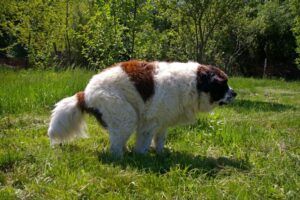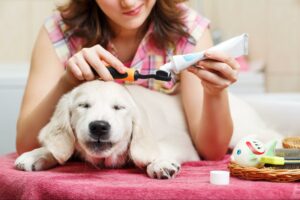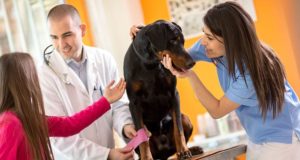It’s probably a dream of a lot of dog owners to have a place with a nice fenced-in yard where their dogs can play and explore, but just because that yard is walled off doesn’t mean that it can’t be a dangerous place. There are potential risks — animal, human, and other — that every dog owner should be aware of.
Animal Dangers
Even in a big city, there may be predators about. Coyotes, known to attack and kill smaller dogs, have become common all over North America and in some places have apparently crossbred with wolves, which makes them bigger and more aggressive.
Also, there are two kinds of big cats — jaguars, found in the southwestern United States, and cougars (aka mountain lions), found throughout the west coast of the U.S. and Canada. Both have moved into urban areas and have been known to attack dogs of all sizes.
In the Pacific Northwest, some of the Rocky Mountain States, and most of Canada, bears can be a particular problem. Like big cats, bears are a danger to all household pets and humans.
Non-predatory animals can still be dangerous, especially if your dog tries to attack it. Opossums may bite if confronted, and raccoons can be fierce fighters; both may also carry rabies or flea-borne diseases. Even an animal as seemingly docile as a deer can trample, kick, or head-butt a dog in a panic, and nobody wants to deal with the aftermath of a dog that’s been skunked.
Don’t discount the danger of squirrels or cats entering your yard. While it’s unlikely that either one will favor attack over escape, they can cause your dog to go into an elevated energy state, which can lead to things like injury or heatstroke.
The best way to deter animals from coming into your yard is to not leave anything attractive for them to find. Here are steps to take:
-
Never keep dog food or bowls outside.
-
Tightly seal trash cans and place a cinder block on them if necessary; store them in the garage if possible.
-
Clean outdoor grills after use, and store them in a shed or garage if they’re portable.
-
Don’t leave anything with a sweet scent, like candles, outside at night.
-
Harvest fruit or berries growing in the yard as soon as they are ripe.
-
Never put anything enticing in a compost pile, like meat or sweet-smelling foods.
-
Bring bird feeders inside at night and take them down during the summer.
-
Remove or cover sources of standing water, like puddles, pools, hot tubs, and fountains.
-
Screen in crawlspaces and open spaces under decks and porches.
-
Keep your doggie doors locked at night.
-
Install coyote rollers or barbed wire on top of walls or fences.
-
Install chicken wire at the bottom of walls or fences, extending 18 inches underground.
Human dangers
Unexpected human visitors to our backyards are more common than you’d think. Various utility company employees have to enter to read meters for gas, water, and power; cable, power and telephone workers may have to come in to service wires and repair connections.
This is why it’s always a good idea to be aware while your dog is in the yard. Keep an eye out for commercial vehicles pulling up in front of the house, and an eye on your dog in the back. Bring him inside if you see a meter reader or other utility worker in the area. Also check to see whether your service providers give advance notice or estimated dates for the next meter reading. These often appear on your monthly statement.
Another unexpected and unwanted threat: dognapping, which has been on the rise lately. Frequently, the targets are purebreds that are stolen for resale, but dognappers are also on the lookout for intact males for breeding, large breeds for dogfighting, and any dog they think they can use to extort the owners out of money.
To protect against dognapping, make sure that your fence is secure, and repair any loose slats or gaps in it. Lock gates from the inside. Make sure your dogs are spayed or neutered, and provide them with permanent identification — either a microchip or tattoo.
To protect your dog from both dognappers and meter readers, never leave them alone in the yard when you’re not at home, and keep an eye on them while they’re in the yard.
Finally, there are the humans you expect, like gardeners and pool cleaners. Generally, they work on a set schedule, so it’s easy to make sure your dog isn’t outside when they come over. However, it’s a good idea to introduce these workers to your dog so she knows that they are “authorized” and won’t freak out when they enter the yard. You should also give them a “no open gates” policy, in case your dog gets out of the house while they’re working.
Finally, you’ll never know when a neighbor or someone else might come into your backyard — for example, the kids next door knocked a ball over the fence and come to get it. Posting “Beware of Dog” signs is a good way to deter these unexpected visitors and redirect them to your front door.
Other Dangers
Your yard can be full of hidden hazards, and it’s your job as Pack Leader to find and get rid of them. Constantly check all of your walls and fences to find breaks or other possible escape routes and fix them promptly. Also watch for any signs that your dog is digging in the yard, especially next to a fence, and fill them in. Consider investing in a chicken wire barrier extending eighteen inches under the fence if your dog is an habitual digger.
Make sure that your walls are too tall for your dog to jump over. Many breeds can clear a six-foot barrier. Avoid placing trash bins or other launch platforms next to exterior fences — put them next to the house, instead — and consider adding vertical extenders to walls and fences or installing coyote rollers, which can keep dogs in as well as predators out.
Another danger can be growing right in your own backyard. There is a long list of plants that are toxic to dogs, and the safest approach is elimination. If you have any of these growing in your yard, consider removing them and replacing them with non-toxic plants. Also check your yard regularly for any mushrooms, toadstools, or fungus that may have started growing, and remove them immediately.
Dogs and yards naturally go together, giving them their own private park and a sense of territory. However, as Pack Leaders, it’s our job to make our yards as safe as possible.
What “dog dangers” have you encountered in your yard, and how were you able to eliminate them? Let us know in the comments!











